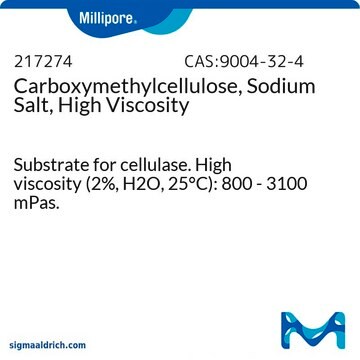If this product has an expiration or retest date, it will be shown on the Certificate of Analysis (COA, CofA). If there is no retest or expiration date listed on the product's COA, we do not have suitable stability data to determine a shelf life. For these products, the only date on the COA will be the release date; a retest, expiration, or use-by-date will not be displayed.
For all products, we recommend handling per defined conditions as printed in our product literature and website product descriptions. We recommend that products should be routinely inspected by customers to ensure they perform as expected.
For products without retest or expiration dates, our standard warranty of 1 year from the date of shipment is applicable.
For more information, please refer to the Product Dating Information document: https://www.sigmaaldrich.com/deepweb/assets/sigmaaldrich/marketing/global/documents/449/386/product-dating-information-mk.pdf
C5678
Carboxyméthylcellulose sodium salt
low viscosity
Synonyme(s) :
Carboxyméthylcellulose de sodium
Sélectionner une taille de conditionnement
Sélectionner une taille de conditionnement
About This Item
Produits recommandés
Source biologique
synthetic (organic)
Niveau de qualité
Forme
powder
Couleur
light yellow
Plage de pH utile
(20 °C, 10 g/L, 68 °F neutral)
Viscosité
50-200 cP, 4 % in H2O(25 °C)
Pf
> 300.05 °C ((> 572.09 °F ))
Solubilité
water: soluble
Traces de cations
Na: 6.5-9.5%
Température de stockage
room temp
Chaîne SMILES
[Na].OC(C(O)C(O)C=O)C(O)CO.OC(=O)C
InChI
1S/C6H12O6.C2H4O2.Na/c7-1-3(9)5(11)6(12)4(10)2-8;1-2(3)4;/h1,3-6,8-12H,2H2;1H3,(H,3,4);
Clé InChI
DPXJVFZANSGRMM-UHFFFAOYSA-N
Vous recherchez des produits similaires ? Visite Guide de comparaison des produits
Description générale
Application
Notes préparatoires
Under normal conditions, the effect of temperature on solutions of this product is reversible, so slight temperature variation has no permanent effect on viscosity. However, long periods of heating CMC solutions at high temperatures (autoclaving) will degrade the product and permanently reduce viscosity. CMC is therefore very difficult to sterilize. γ-Irradiation, like heating, will degrade CMC. High viscosity CMC is more adversely affected by autoclaving and irradiation than is low viscosity CMC. Filtering CMC solutions tends to leave a gel behind because the material is fibrous, so solutions cannot be sterile filtered.
Autres remarques
Code de la classe de stockage
11 - Combustible Solids
Classe de danger pour l'eau (WGK)
WGK 1
Point d'éclair (°F)
Not applicable
Point d'éclair (°C)
Not applicable
Équipement de protection individuelle
Eyeshields, Gloves, type N95 (US)
Faites votre choix parmi les versions les plus récentes :
Certificats d'analyse (COA)
Vous ne trouvez pas la bonne version ?
Si vous avez besoin d'une version particulière, vous pouvez rechercher un certificat spécifique par le numéro de lot.
Déjà en possession de ce produit ?
Retrouvez la documentation relative aux produits que vous avez récemment achetés dans la Bibliothèque de documents.
Les clients ont également consulté
-
How can I determine the shelf life / expiration / retest date of this product?
1 réponse-
Utile ?
-
-
How is shipping temperature determined? And how is it related to the product storage temperature?
1 réponse-
Products may be shipped at a different temperature than the recommended long-term storage temperature. If the product quality is sensitive to short-term exposure to conditions other than the recommended long-term storage, it will be shipped on wet or dry-ice. If the product quality is NOT affected by short-term exposure to conditions other than the recommended long-term storage, it will be shipped at ambient temperature. As shipping routes are configured for minimum transit times, shipping at ambient temperature helps control shipping costs for our customers. For more information, please refer to the Storage and Transport Conditions document: https://www.sigmaaldrich.com/deepweb/assets/sigmaaldrich/marketing/global/documents/316/622/storage-transport-conditions-mk.pdf
Utile ?
-
-
Is the carboxymethycelluose sterile?
1 réponse-
This product is not sterile.
Utile ?
-
-
I want to ask the degree of substitution of this CMC (C5678-500G). Thanks in advance.
1 réponse-
As mention on the Product Specification Sheet, the acceptable range / quality specification for Degree of Substitution is 0.65 - 0.90 carboxymethyl groups per anhydroglucose unit.
Utile ?
-
-
I want to know the molecualr weight of the Carboxymethylcellulose sodium salt low viscosity (C5678-500G)
1 réponse-
The molecular weight is not determined for each lot, however, historical information indicates a molecular weight of approximately 90 kDa.
Utile ?
-
Filtres actifs
Notre équipe de scientifiques dispose d'une expérience dans tous les secteurs de la recherche, notamment en sciences de la vie, science des matériaux, synthèse chimique, chromatographie, analyse et dans de nombreux autres domaines..
Contacter notre Service technique

